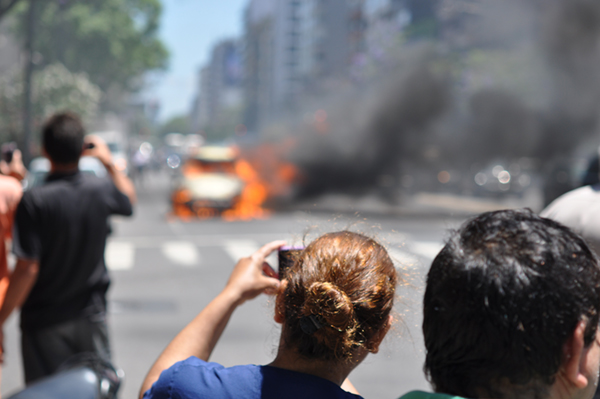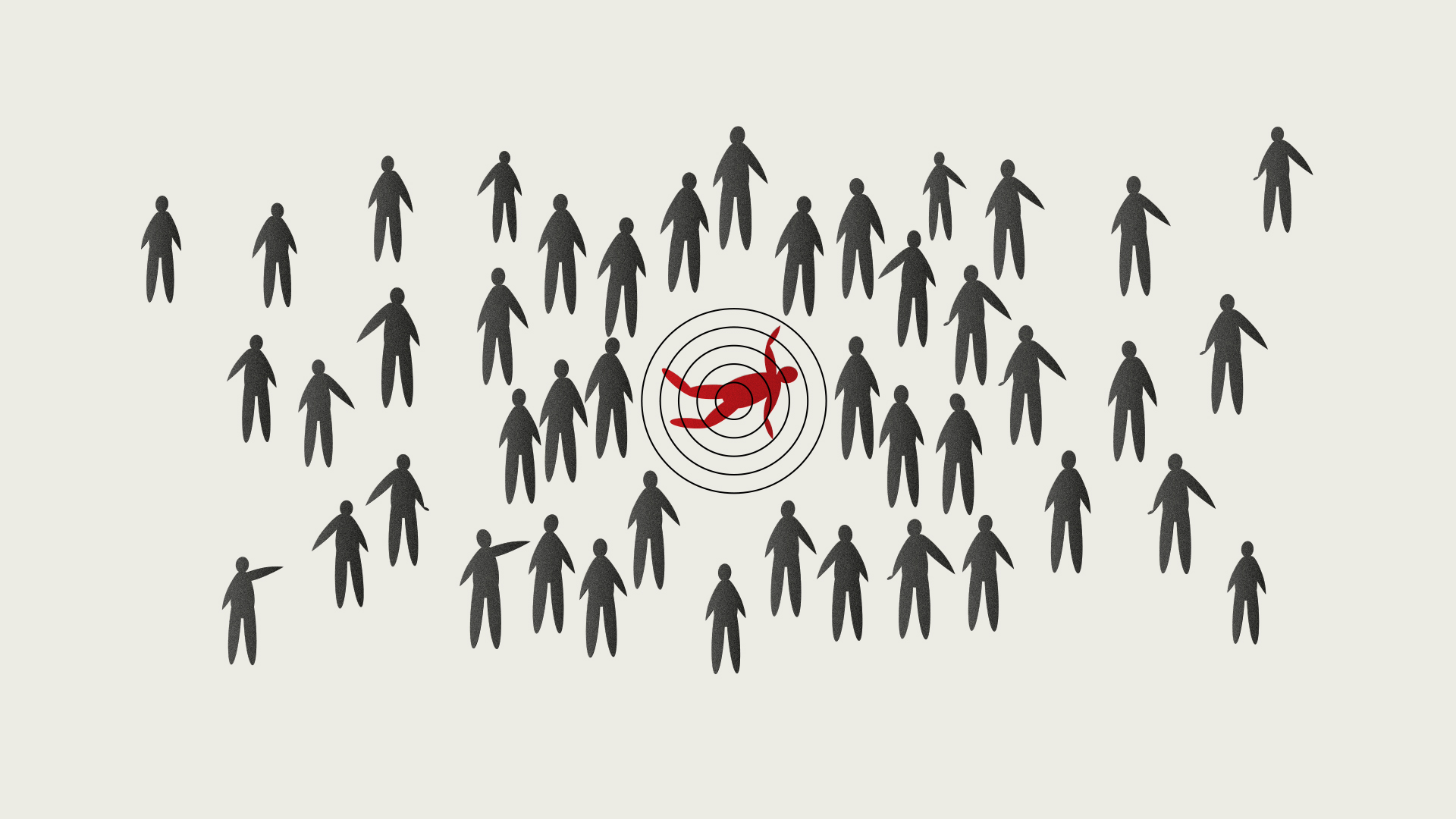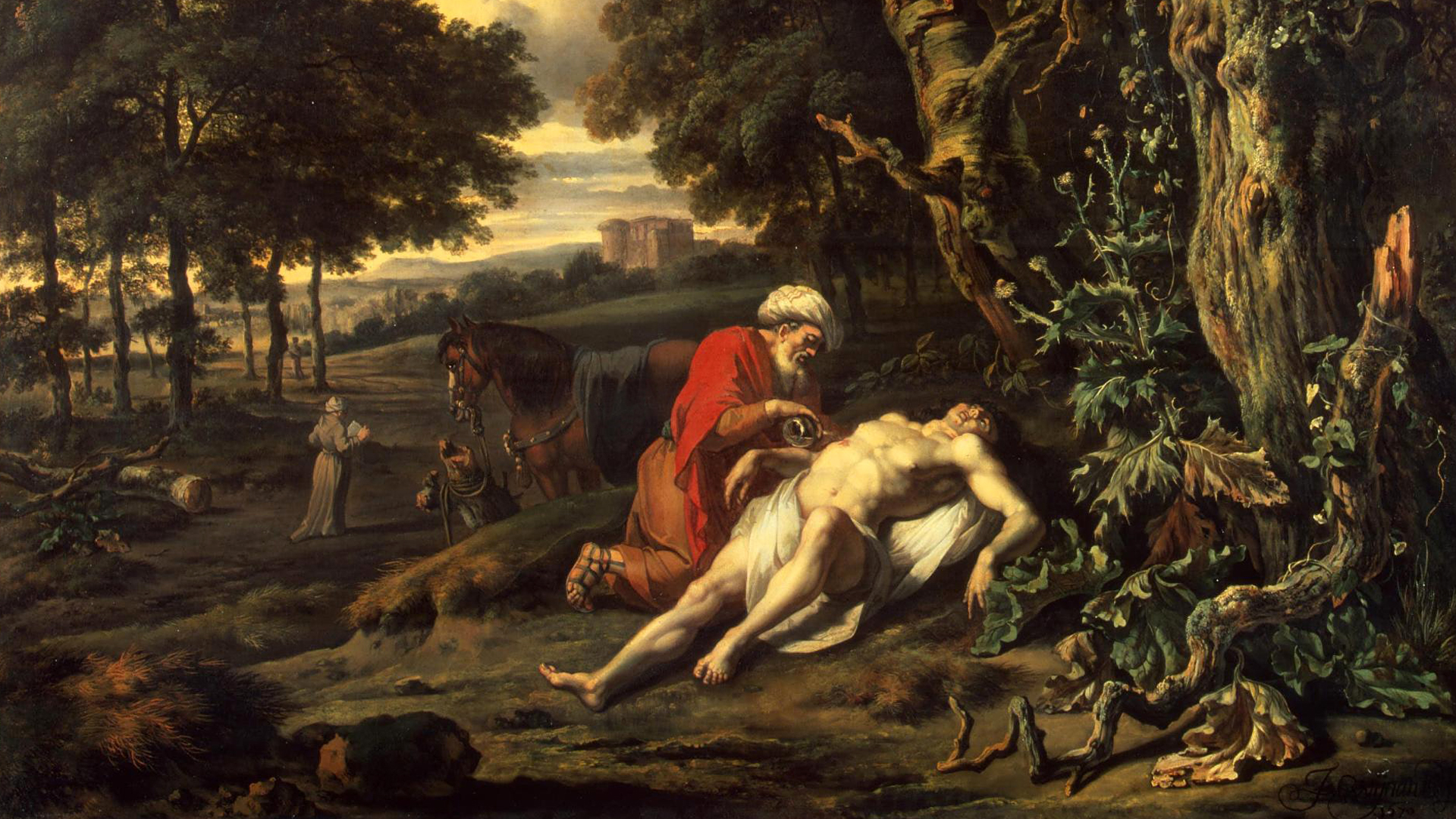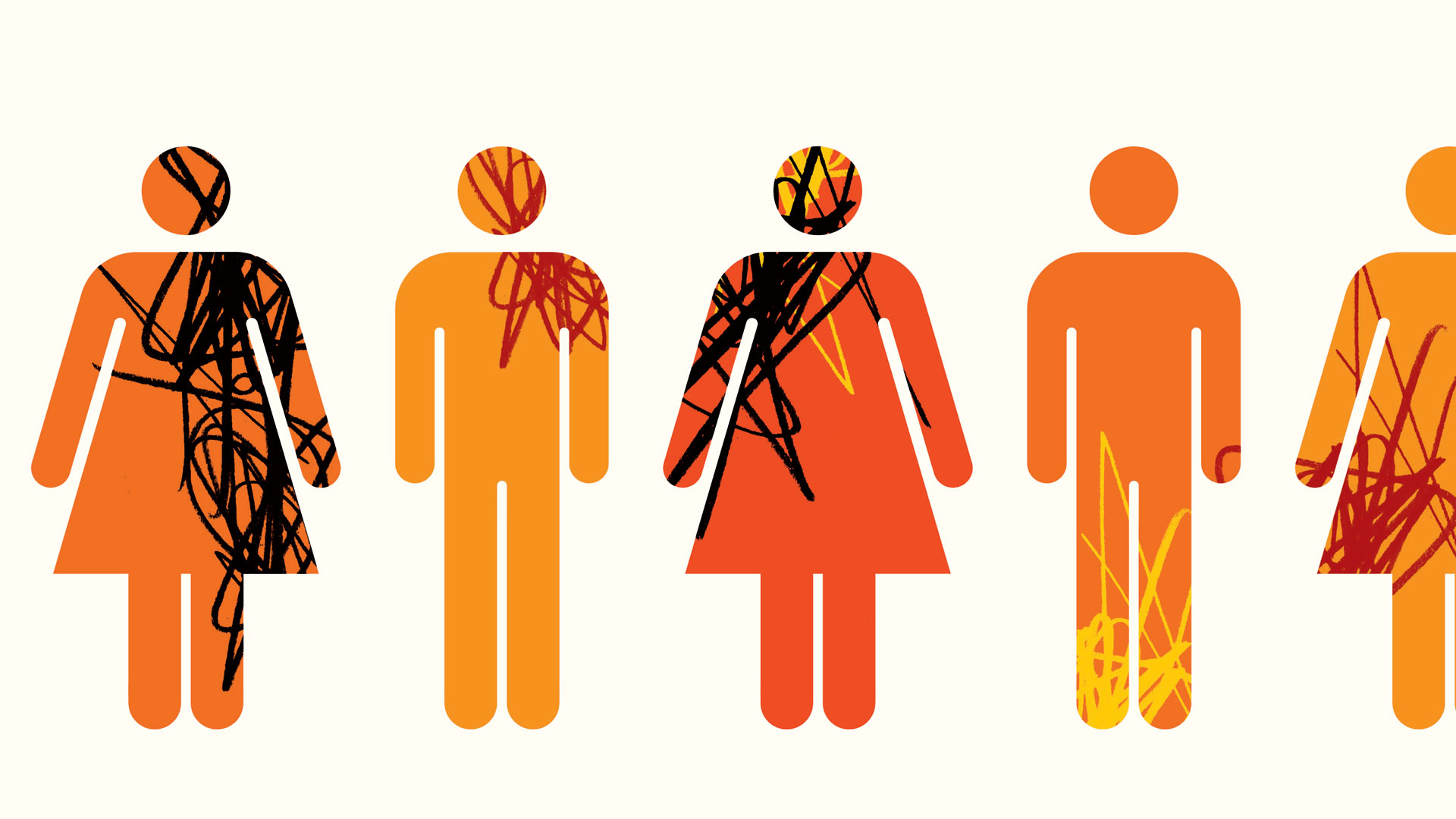Crowds Without Heroes
Bystander Inaction in Action
Why does a crowd of witnesses so rarely intervene to help a person who is obviously in trouble? And what does it take to be the person who does?
They’re on subway platforms in Paris, London, New York, Sydney and Montreal. They’re on riverbanks in Florida and canals in Venice, and in schools, shopping centers and streets around the world. And they’re all over cyberspace.
Who are they? They’re bystanders who witness harm being inflicted on others. Yes, some may act quickly to intervene without regard to personal safety. Shockingly, others may actually join in the abuse. More often, though, the crowd simply freezes, watching the scene unfold.
In January 2018, for instance, a man was stabbed on a Paris subway platform after an altercation with another passenger. As he bled to death on the platform, onlookers filmed him and posted images to social media.
In Rajasthan, India (July 2018), a school bus hit a motorcycle carrying three men. One was killed on impact, but the other two lay in a pool of blood for half an hour pleading for help while onlookers recorded video and clicked selfies with them.
Horrifying, right? Most of us imagine that, had we been among the bystanders, we’d immediately have gone to the rescue or at least called the police.
As comforting as that thought may be, however, research suggests otherwise—and so does history. It’s easy to don a cloak of righteous indignation, but it often turns out to be just a gossamer veil. The reality is that unless there is at least one morally secure and compelling leader who has the support of a number of the bystanders, group dynamics favor inaction.
What would it take to emerge as a force for good in such a situation?
The Bystander Effect
Researchers began to study bystander inaction seriously in 1964, after 28-year-old Kitty Genovese was stabbed outside the New York City apartment where she lived. The attack took place in view of an indeterminate number of her neighbors and probably within earshot of more. She screamed during that initial attack, at which point one neighbor shouted down through his window (a well-meaning if often ineffectual form of intervention). The attacker did flee, but 10 minutes later he returned to find Genovese in her building’s vestibule, where she had crawled. He stabbed her again, sexually assaulted her and stole her money. After he left, a female neighbor found her and remained by her side in comfort; but physical intervention, when it did come, was too late. Though one neighbor is known to have called the police more than half an hour after the first screams, Genovese died on the way to the hospital.
Ironically, her killer was captured a few days later thanks to two bystanders at a very different crime: a daytime home burglary. After confronting the perpetrator as he loaded a television into his vehicle, the two neighbors were unconvinced by his explanation; so while the man went back to the house for more loot, they disabled his vehicle and called the police. The thief, who fled on foot, was caught and soon confessed to a series of burglaries as well as to three murders, including that of Genovese.
News coverage of Genovese’s murder was quite muted at first, but two weeks after the event, the New York Times published a story that wildly sensationalized the negligence of her neighbors that night. Sensational or not, research into the phenomenon began soon after.
By 1970, psychologists John Darley and Bibb Latané had reproduced “the bystander effect” in a series of studies, finding that one person observing an emergency almost always reported it calmly and immediately; however, when more observers were present, reporting dropped off dramatically. The researchers suggested that the reduction was related to the decision-making process bystanders must undergo in order to intervene. In a 1981 summary of his research, Latané explained it this way: “The bystander must notice the event, interpret it as an emergency, feel personally responsible for dealing with it, and possess the necessary skills and resources to act.”
The more people present in a crowd of onlookers, the more likely that these decision-making steps will be delayed, and the longer they are delayed, the less likely anyone is to respond.
“Let not any one pacify his conscience by the delusion that he can do no harm if he takes no part, and forms no opinion. Bad men need nothing more to compass their ends, than that good men should look on and do nothing.”
According to Latané, three general influences come into play in a bystander’s decision not to intervene: audience inhibition, social influence and diffusion of responsibility.
Onlookers are inhibited by their concern that others will see and judge their behavior—if, for example, it seems unclear whether the person is actually in need of help. The would-be rescuer might also hesitate for fear of personal consequences, worrying that the attacker might retaliate or even that the victim might later sue for any injuries suffered during a rescue.
Social influences also contribute heavily, since people tend to look at the cues from others in the group around them to determine their own behavior. If no one else is helping, says Latané, bystanders are likely to assume the situation isn’t critical and to conclude that the expected and appropriate response is to do nothing.
Social status of the victim may also come into play. In New York City in April 2010, a surveillance camera captured an attempted mugging, in which a Good Samaritan intervened to save the female victim. As she fled, the mugger turned his attention to the hero, a homeless man. After being stabbed several times, Hugo Alfredo Tale-Yax collapsed on the sidewalk and was passed by more than 20 people, none of whom stopped to help the dying vagrant.
Diffusion of responsibility is the individual’s sense that with so many others present, the psychological cost of nonintervention is reduced. “The knowledge that others are present and available to respond, even if the individual cannot see or be seen by them,” says Latané, “allows the shifting of some of the responsibility for helping to them.”
Crossing Boundaries
In some situations, bystanders have gone further than inaction, crossing over to identify with the offender(s).
Something of the kind may have been a factor in Richmond, California, when a 16-year-old girl was sexually assaulted multiple times after leaving early from a school dance in October 2009. In the two and a half hours spanned by the attacks, which took place in a dimly lit school courtyard while the dance continued inside, as many as 20 witnesses allegedly watched without calling 911. Six men were eventually convicted on rape and other felony charges, though DNA evidence indicates that more were involved.
According to news reports, the Richmond High School student and her family sent a series of public messages to the stunned community over the following week emphasizing that “violence is always the wrong choice.” Acknowledging that anger was justifiable, they urged the community to “let the anger cause change; change that is necessary to keep our children, our neighbors and our friends safe.”
These cautions were well-founded, given reports that vigilante violence was being threatened by “local toughs” in the days following the attack. While violent retaliation is unsanctionable, it’s interesting to observe how much easier it is for a crowd to unite in retaliation than in intervention.
Many found themselves at a loss to explain the behavior of those bystanders who observed the nonstop attacks without intervening. Although some of the observers had cell phones, news reports say they were used to take pictures or video rather than to press the three digits that would have meant so much.

There were a couple of heroes in the piece, however—although they were not among the crowd. According to one newspaper report, “news of the ongoing rape eventually reached Raul Rubio from passers-by, as he stood on a corner with friends about a block from campus. After verifying the claim, he went to his girlfriend’s nearby home, and she called 911.”
Police found the girl unconscious and in critical condition. Although she spent much of the next week in the hospital and had been mentally traumatized in ways that would be difficult for anyone to recover from fully, physically, at least, she survived.
“In gang rape, as in individual rape, sex becomes an expression of power and anger,” say researchers Nicholas Groth and H. Jean Birnbaum. “However, one of the unique dynamics in gang rape is the experience of rapport, fellowship, and cooperation with the co-offenders. The offender is not only interacting with the victim, he is also interacting with his co-offenders. In fact, it appears that he is using the victim as a vehicle for interacting with the other men. He is behaving, or performing, in accordance with what he feels is expected of him by them. He is validating himself and participating in a group activity.”
Crossing the group boundary between bystander and offender, then, requires at least some identification with those in the criminal group, and a desire to be accepted within it. “Men compete with each other to win recognition and esteem,” Groth and Birnbaum explain. “Similarly, criminals compete in antisocial acts, and for the gang rapist, the sexual assault is the product of both internal motives and group dynamics.”
By the same token, group dynamics can come into play on the heroism side. Bystanders who know each other are more likely to intervene than those who don’t.
Stone-Cold Indifference
Of course, bystander inaction may sometimes simply be put down to an individual observer’s outright apathy and disregard for others. Just ask Christine Wellstead, a Canadian nurse who happened across an unconscious homeless man near a busy Vancouver coffee house one night in 2005. Slumped on a bench and wrapped in a burning blanket, the man was difficult to ignore as clouds of acrid smoke emanated from him. Nevertheless, no one intervened until Wellstead arrived on the scene.
Even then, as the nurse tried to put out the fire, one of the bystanders—calmly drinking her coffee nearby—continued a casual conversation over her cell phone. Another observer, a customer inside the coffee shop, advised, “Just leave him alone, he’s a homeless person.” Appalled and insistent, Wellstead doused the fire and then instructed a barista to call for an ambulance, to which the same customer responded, “Don’t call the hospital, they don’t want him.”
When Wellstead finally succeeded in waking the man, she learned he was prone to seizures and had likely had one while smoking and wrapped in his blanket.
“I know there are a lot of homeless people here and I know some of them can be annoying, but this was a human being.”
Adam Welch, who was seriously slashed in 2006 by a fellow passenger on a crowded London bus, experienced a similar case of apathy. As his attacker disembarked, Welch pleaded for help from the remaining passengers, to no avail. The man sitting next to him just shrugged in response, and Welch was finally forced to struggle down the stairs of the double-decker under his own power in order to alert the driver, who called an ambulance.
The Other Side of the Coin
While stories like these focus primarily on people who don’t act, Latané and Darley were quick to point out that “people sometimes do act. . . . For every ‘apathy’ story, one of outright heroism could be cited.”
What makes a bystander choose to act, then? Keeping in mind what we know about why they don’t, it makes sense to conclude (as Latané and Darley did) that for someone to act, he or she must
- notice the event;
- interpret it as a problem;
- feel personally responsible for taking action;
- possess the skills or resources to help.
An interesting detail common to many rescue stories is the presence of an off-duty policeman, fireman, nurse or other crisis responder. Obviously such people already fit the necessary profile: they are mentally prepared to notice, size up and take responsibility for acting in emergencies, and they have the skills to do so. But people who choose work in “helping professions” probably place a high value on compassion to begin with.
So what about the rest of us? Researchers who study decision-making tell us that we don’t really make complex decisions from a purely rational standpoint; our best decisions often require a healthy dose of feeling alongside rational thinking. This can be especially important in cultures where Good Samaritan and Duty to Rescue laws (meant to encourage intervention) have become so variable and confusing that if pure logic were to override basic human sympathy in making the decision to intervene, it’s possible no one would ever intervene at all.
But assuming that basic human sympathy and compassion are still alive and well—even among those who aren’t in helping professions—there are things each of us can do to prepare ourselves for being a bystander who acts, whether we witness an assault on the street or someone being bullied online.
“Altruism is not completely dead.”
The most successful bystander intervention training programs focus on the four skills noted above by: 1) teaching people how to pick up on red flags and warning signs, 2) encouraging proactive steps such as asking others in the crowd what they think about what is happening and enlisting them to help you investigate, 3) teaching responsibility to act, and how to engage others in acting alongside, and 4) teaching practical skills for intervening safely and appropriately.
The fourth requirement may seem daunting. How many of us really know how to rescue someone caught in a rip tide, or to disable an armed attacker, much less have the physical strength to do it? Then again, don’t most of us have a mobile phone in our pocket? It’s interesting how often in news stories we read about onlookers standing by with their mobile phones video-recording an attack. True, the reward for having a video go viral may initially seem greater than the reward for calling emergency services, but your viral video will also speak volumes about the quality of your character when your audience realizes you didn’t call for help instead of turning on the camera.
In fact, at the end of the day, the discussion seems to come down to that very issue: personal character. Without stating it outright, Latané and Darley are hinting at what philosophers and theologians might call “a strong moral character” when they describe those heroes among us who do take action to help those in trouble. To notice and interpret a problem implies the ability to make value judgments; and to feel personally responsible for taking action implies that not taking action would go deeply against the grain.
While those in different fields might use different terms, the essentials are the same: To be that person in the crowd who intervenes requires a level of character that compels us to willingly take responsibility to act on behalf of the welfare of others. And that clearly is our responsibility to one another within our communities—not to just have one hero in every crowd, but to have entire crowds of heroes.



